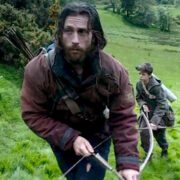Slamdance 2020: TAHARA & BIG FUR

Kristy Strouse is the Owner/Editor in Chief of Film Inquiry,…
Right up the road from Sundance in Park City Utah is the yearly Slamdance Film Festival. I was able to catch a couple films from the 2020 lineup, Big Fur and Tahara, and both were wildly different, but equally compelling.
Tahara (Olivia Peace)

Tahara draws from a simple enough idea for a film, and yet this debut, from first time feature director Olivia Peace and writer Jess Zeidman, draws strength from the fact that nothing is really ever “simple” when death, sexuality and being a teenage girl are concerned; there’s always a lot to discuss.
This coming of age drama follows best friends Carrie Lowstein (Madeline Grey DeFreece) and Hannah Rosen (Rachel Sennott) after one of their classmates at a Hebrew school commits suicide. The film covers how the day unfolds as they each process things. Basically, the movie revolves here, in this location and day, which suits the quick 82 minute runtime. We all experience grief differently, and while the school tries to help them assimilate, there are various student reactions.
There’s another element of the story that’s equally important and represented. After the two girls share a kiss for “educational purposes”, the perception and differing meanings creates a seperation between them. For Carrie, Madeline Grey DeFreece especially (who stands out here) her world is upended as she tries to work through her feelings for Hannah and her own sexuality.
There is also some re-accessing of their bond and the potential dissolution of their friendship. They are both working through their own paths of self discovery, and Hannah is overly concerned with social status and getting the attention of the boy she likes regardless of the cost with Carrie. I was really impressed by the performances of both the actresses who seem emotionally and personality-wise quite different, but yet have a bond that’s evident. It’s a funny film, with dialogue that seems present and real. There is also acknowledgement to the technological/ social media era we reside in that creates an interesting map of the youngsters on screen.
Some quick shots of animation, conveying the girl’s imaginations, are also wonderfully woven in. The beginning and end shots are a car going to and from school, signifying the containment of the narrative, but also reminding us that change can happen fast. It’s an impressive feature on all fronts, and its staying power, at least for me, speaks bounds.
Tahara delivers some characters and situations that don’t always get an opportunity to be explored, but deservedly should. Peace and Zeidman’s collaboration proves to be a touching, (heartbreaking at times) story that takes one day and shows the momentous connotations of it. Keep an eye out for all the talented women involved in Tahara, their cinematic futures are ones to watch.
Big Fur (Dan Wayne)

There’s a lot packed into this documentary, much more than initially meets the Sasquatch eye. Dan Wayne’s film follows experienced taxidermist Ken Walker as he walks us through the process (based on first hand accounts and the classic Patterson–Gimlin film) of making Bigfoot. With a lot of history and the practice and art of taxidermy, married with Ken Walker’s visual creation of Big Foot, Big Fur is entertaining stuff. There is a lot of love and patience put into what he does, and his talent is visibly obvious. At times his process lulls you, transfixed by the details put in.
His curiosity and investigation regarding Sasquatch make it even easier to entertain what’s being shown. Interesting music by Brad Cox and stylistic choices by director Dan Wayne (including a claymation scene) periodically inject vitality into the film, creating a very original tone. Walker is quite enthralling on his own though, and for some, he will strip your preconceptions (and misconceptions) about taxidemery down, to show the beauty in the intricacies.
With moments of deep insight and interesting theories, by the end, Big Fur has crafted something rather unique (and I don’t just mean Ken’s Bigfoot- which I was lucky enough to see in person). This is a quirky little piece that feels authentic in its journey, even for the skeptics out there. Big Fur is a story of man as much as it is myth, and it’s a fascinating one.
I was able to sit in on an interview with director Dan Wayne and star Ken Walker conducted by the ISA’s Scott Markus, here’s a bit of what was discussed:
When talking about the topic and presentation of the idea, Director Dan Wayne said he was interested in taxidermy to start. ”I was looking for something to get me away from the computer that was a little more old school, traditional, where I could use my hands. I was attracted to that combination of art and craft, and science that is required.” He felt that there was something here, a story to tell. “I was fascinated by it. I thought, there’s a great documentary here somewhere and I knew it would be character driven because these guys were real characters.”

Ken’s work specifically caught his eye. “Ken is kind of known as a mammal taxidermist, but he’s really known for his recreations. Which are very specific and they require a lot of research and creativity. It involves and building another animal, like an extinct or injured animal out of other animal hides.” When mentioning how the specificity of the documentary came up, he further discussed his conversations with Ken. “I knew he had a thing about Bigfoot, but I didn’t know how obsessed he was with it. I sent him a message and he called me back, immediately started talking about Bigfoot and then said he was going to build one. And I thought: that’s the movie.”
Ken mentions the start of the collaboration. “In the very beginning Dan was kind of vague, as he wanted to do a documentary about someone in the taxidermy industry. Then we got into the whole conversation about it. Then I talked about the investigations I had been doing in the hunting community with people who had seen Sasquatches. Everyone that comes into my shop gets the third degree, then they send their friends in. I ended up getting so many amazing accounts from people and I started going out into the field and investigating sightings and things like that.”
Ken also mentions how he crafted his recreation of Bigfoot, and how real the classic video is: “I looked at the Patterson film. And, to a trained eye, you only have to look at it for a few seconds to realize it’s not fake. All of the limb ratios are outside of human parameters, all of them. If you have a trained eye like I do, you see this right away. And I’m like… I have reference to build something. I don’t like building anything without some kind of reference or really good investigation. So, I decided to build the Patterson creature solely what was on that film. I didn’t really embellish anything I just built what had been recorded.”
The two also talked about making the film in a way that made everyone comfortable and telling Ken’s story seriously. Ken mentioned, “I have zero fear of ridicule. None whatsoever. I can make fun of me better than anyone. That made things easy.”
Dan went on further: “It is tricky, it’s something I thought about very hard through the whole course of editing because, I knew pretty quick that it was going to be a comedy, a lot of it borders on the absurd. And Ken is funny! It is one of the reasons I wanted to make a movie about him. In film, you kind of walk that fine line.” Dan also mentioned, when asked about some of the creative choices, wanting to bring other, collaborative elements in: “It which it infinitely more interesting to me than just watching the same thing over and over. The claymation was a natural thing because that’s what Ken used to do. We put that intentionally, wanted in the beginning, to let people know “It’s okay to laugh, this is a funny story.”
He detailed the musical collaborations and ways he shot certain sequences. “Watching him do his work, always felt like a dance to me. Like he’s dancing with this Sasquatch. It seemed natural to me, it’s a rhythm.”
Ken felt comfortable with Dan, “It’s not my movie, it’s about me. I had high hopes and total faith that Dan was going to make an honest movie. There was a lot in there that could have been used out of context that could have even been damaging to people. It’s a very, very honest movie. If I just stepped out of myself and watched it that way I found it extremely entertaining.” When asked about how it’s been seeing it it Slamdance, Ken felt it was a entirely different experience. “With the audience, I can feel the empathy in the room and it hits me a lot harder. I get caught up and connect with the audience.”
You can check out the ISA video made by Scott Markus, here.
We want to thank Dan Wayne and Ken Walker for speaking with us. Both films had their premiere at Slamdance 2020. For more information go here.
Did you make it up to Park City to catch either? Let us know your thoughts below!
Does content like this matter to you?
Become a Member and support film journalism. Unlock access to all of Film Inquiry`s great articles. Join a community of like-minded readers who are passionate about cinema - get access to our private members Network, give back to independent filmmakers, and more.
Kristy Strouse is the Owner/Editor in Chief of Film Inquiry, writer, podcaster, and all around film and TV fanatic. She's also VP of Genomic Operations at Katch Data and is a member of The Online Association of Female Film Critics and The Hollywood Creative Alliance. She also has a horror website: Wonderfully Weird & Horrifying.












